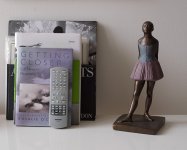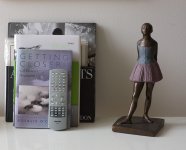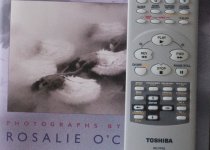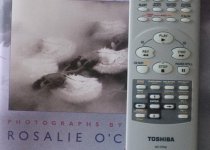jlw
Rangefinder camera pedant
A number of people seemed disturbed by my recent thread in which I subjectively observed that in one particular picture-taking situation, the pictures I shot with my 6-megapixel R-D 1 seemed better in overall quality than the ones I shot the next night with my 10-megapixel Nikon D80.
To subject this to something more closely resembling a "controlled test," I did some more careful test photos today. Rather than let the cat out of the bag right away, I think I'll show the results first and then disclose which are which. (No fair peeking at the EXIF data!)
Test conditions: both cameras set to EI 1600; Nikon's "High ISO Noise Reduction" at default setting; both with 50mm lenses (C-V Nokton for the Epson, 50/1.8 AF Nikkor for the D80) set to f/8. I set exposures by making test shots at different exposures until I got histograms as far to the right as possible on both cameras' displays without entering the clipping region; as it happened, the shutter speeds were very close to each other.
One important difference from my earlier non-test is that in this case I was using diffused daylight; the first time around, the lighting was tungsten. Various people, such as Sean Reid, have noted that tungsten lighting is an especially tough noise-control challenge since the gain of the blue channel has to be turned up so drastically to get neutral color rendition. So, eventually I'll have to repeat this process with tungsten light to see whether the results differ significantly from daylight.
Now, here's what I got. The first set of attachments show my test scene overall; I've downsized the photos to be RFF-friendly and cropped them to look as identical as possible, so this is just a reference:
To subject this to something more closely resembling a "controlled test," I did some more careful test photos today. Rather than let the cat out of the bag right away, I think I'll show the results first and then disclose which are which. (No fair peeking at the EXIF data!)
Test conditions: both cameras set to EI 1600; Nikon's "High ISO Noise Reduction" at default setting; both with 50mm lenses (C-V Nokton for the Epson, 50/1.8 AF Nikkor for the D80) set to f/8. I set exposures by making test shots at different exposures until I got histograms as far to the right as possible on both cameras' displays without entering the clipping region; as it happened, the shutter speeds were very close to each other.
One important difference from my earlier non-test is that in this case I was using diffused daylight; the first time around, the lighting was tungsten. Various people, such as Sean Reid, have noted that tungsten lighting is an especially tough noise-control challenge since the gain of the blue channel has to be turned up so drastically to get neutral color rendition. So, eventually I'll have to repeat this process with tungsten light to see whether the results differ significantly from daylight.
Now, here's what I got. The first set of attachments show my test scene overall; I've downsized the photos to be RFF-friendly and cropped them to look as identical as possible, so this is just a reference:
Attachments
Last edited:







